

(Available on the first of each month to Tile Heritage members who e-mail the Foundation from the address they
would like
E-News sent to. Contact: foundation@tileheritage.org)
Tile Heritage has arranged with the San Francisco Airport Museums for a special tour of the “California Tile”
exhibition for THF members on Sunday, November 14, 2004 at noon. Due to national security precautions currently
in effect, the public is not allowed in this part of the airport, only ticketed passengers on United. An exception
is being made for THF members and staff to view this extraordinary exhibit. The size of the group is limited to 25
and pre-registration is required. If you are interested and available, please email THF at foundation@tileheritage.org
as soon as possible to reserve your place. Reservation deadline: October 31st. First come first served! (If you have
allowed your membership to lapse, perhaps this would be a good time to renew!)
Sheila Menzies and Joe Taylor drove to Lake Tahoe in late September to attend the annual TCAA convention,
specifically the luncheon honoring this year’s Cesery Award recipient, John Sekora.
Founded in 1903, the Tile Contractors’ Association of America – TCAA – was incorporated in 1928 as a nonprofit
organization serving ceramic tile contractors throughout the United States. Its professional member contractors
rely on TCAA to keep them current on everything that affects the installation of ceramic tile.
The Carl V. Cesery Memorial Award ranks high among the national honors granted by American trade, industry and
professional groups and serves to distinguish any person from any source who has served the American tile trade
with great distinction.
All who have received the award are met with a marked measure of personal success;
all have figured prominently in the American tile trade; all have taken an active part in their respective national
bodies;
and all have given their time and effort to the common good of all those who make a living out of the
production and installation of ceramic tile.
John J. Sekora, a personal friend and an outspoken advocate of the Tile Heritage Foundation, is the CEO and owner
of Artisan Tile & Marble Co. of N.J., Inc. He has served as both president and treasurer of the New Jersey Tile
Contractors’ Association and was president of TCAA in 2000-2001. Noted as the “official TCAA historian,” John
was acknowledged for his efforts in compiling Ceramic Tile in 20th Century America, a book that traces the history
of tile installation over the last 100 years.
Congratulations John!
On our return from Lake Tahoe, we stopped in Grass Valley to visit our friends Caroline Courtright and Rodger Dunham
at their new location in the Sierra foothills. Three years back while visiting friends in the area the couple fell
in love with this place and within days picked up their stakes in Sonoma County and made the move. And what a
splendid choice!
The salvage work at the old Steinhart Aquarium in Golden Gate Park, San Francisco, has been completed. James Dawes of
PlaceMakers Inc. was the primary contractor on the job, which took 32 days to finish. Tile Heritage board member, Riley
Doty, worked with Dawes for 18 days, mainly on removing tiles from the rim of the alligator pit and the lower band of
decos around the perimeter of the room.
Barb is a good communicator, and we will keep on this.
Tile Heritage has heard from Rhonda Heisler of SAMA that Isaiah Zagar’s South Street Magic Garden in Philadelphia is
seriously threatened. The owner of the property in Boston apparently has put demolition on hold temporarily while a
nonprofit organization is established to purchase the property and assure its preservation.
We encourage everyone to visit Isaiah’s website at www.isaiahzagar.org and click
on “Save South Street’s Magic Garden.”
There you will find a number of options from making tax deductible donations and signing petitions, to writing letters
of support to city and state officials.
Isaiah’s Magic Garden, adjacent to his studio at 1022-24 South Street, Philadelphia, has become a landmark visited all
hours of the day and night by people from all over the world. The property must be saved to ensure that it can continue
to be shared, studied and enjoyed by both citizens and visitors to the great city of Philadelphia.
Mary Jane Koenig, archivist and tile enthusiast in Erie, who was responsible for saving the twelve American Encaustic splashbacks
from the old East High School building, has recently informed Tile Heritage that Roosevelt Junior High School is threatened with demolition.
We will keep you posted.
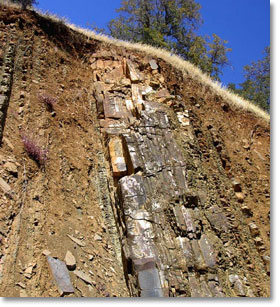
It is with total amazement that we observe California’s geological history as it’s exposed by road cuts,
here high up on the Leesville Road above the Antelope Valley in northern Colusa County. It almost looks
like a stack of bricks, a wonderful example of the muddy sandstones that make up the Great Valley Sequence –
a geological phenomenon that describes the thick section of sea floor sediments that dip from the east flank
of the Coast Range under the Great Valley, the broad fertile plain that stretches from the Coast Range to the
foothills of the Sierra Nevada Range. These sandstones were once layers of mud and sand on the Pacific Ocean
floor. Their layers tilt steeply downward to the east. Over time eroded deposits accumulating on the valley
floor, from stone formations like this, contribute to the birth of clay deposits.
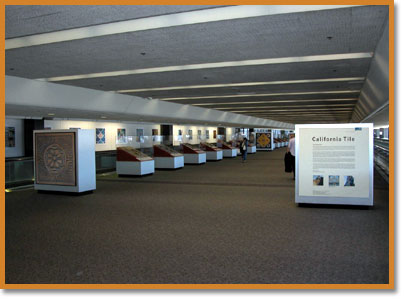
Invitation to
“California Tile”
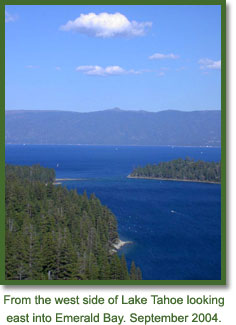
TCAA convenes at Lake

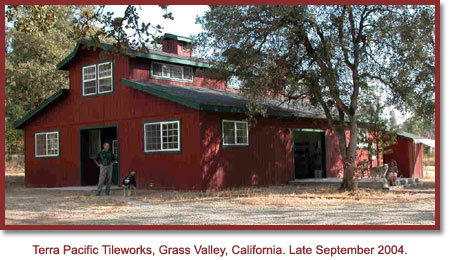
Terra Pacific Tileworks
now in the Sierra Foothills

In the shade of giant live oaks they built a new studio up the drive a short walk from their home
where they are continuing to pursue the tile traditions that Rodger initiated with his ceramic wall sculpture and tile
mural installations nearly 30 years ago.
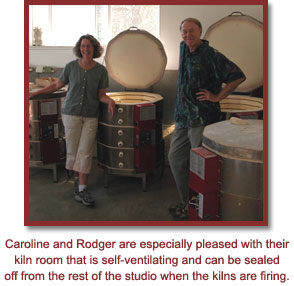
Terra Pacific Tileworks produces handcrafted, decorative relief tiles of exceptional quality. A palette of transparent
colors has been developed to reveal and emphasize the uniqueness of each design; and when combined with the coordinated
field options, an unlimited range of complimentary effects can be achieved. The company’s vast and ongoing array of
theme multiples, serialized and sequential patterns, and consecutive systems offer many workable design solutions to
trade professionals and their clients.
Our friends may miss the ocean air, but they now have the pristine beauty of the mountains around them, ideally suited
to the production of fine ceramic ware.
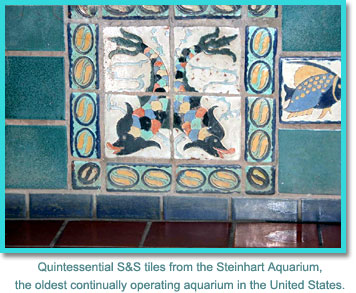
Steinhart Aquarium Update
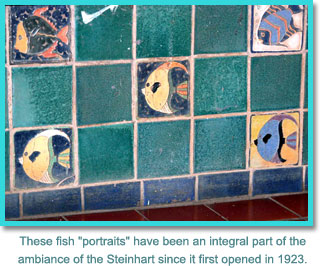
Riley wrote on September 8th, “I’m exhausted and recovering, but happy to report that the Steinhart tiles are salvaged.
The architect eventually did fall in love with the tiles…. He requested that the rock mountain and waterfall installed
as a backdrop in the 1950s be removed so that the tiles from behind that part of the alligator pit could also be removed.
(That portion of the tiled rim hadn’t been visible for 50 years—about 75% of those tiles were intact and were salvaged.)
The plan for the pit will in a sense make it even more visible in the new building because it will be seen from below
as well as above. The floor beneath the swamp will have major display tanks and from that level one will be able to
look up through the alligator pit and see the tiles around the rim from that vantage point also.”
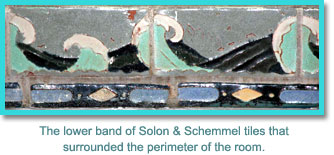
Tile Heritage approached Barbara Andrews, project coordinator at the California Academy of Sciences, for pictures of
the salvaging operation. She responded on October 1st, “…that it would be best if we could wait until the Academy has
more information for you as to the future of the tiles. We have done the removal and they are in storage, but we do not
want to raise interest and questions when we do not yet have options or answers.”
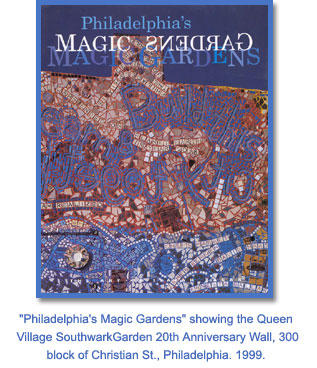
Philadelphia: South Street
Magic Garden Threatened!
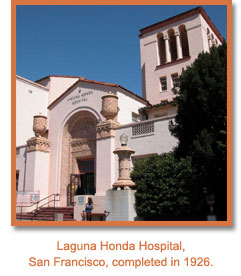
Tile Alert at
Laguna Honda Hospital, San Francisco
The City and County of San Francisco is in the process of constructing a new campus on the Laguna Honda Hospital site
that will provide housing and a complete continuum of long-term healthcare services. It will, by design, encourage
rehabilitation and independent living while setting the standard for enhancement of the quality of life.
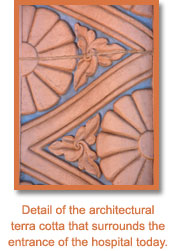
The main entrance to the current hospital is adorned in ornate terra cotta around and above the doorway, including the
adjacent lampposts and two massive, ornamental urns. The lobby of the hospital has an extensive wainscoting of decorative
tiles produced by Solon & Schemmel in 1926, featuring a 3-foot roundel above the door. The inner courtyard has an assortment
of S&S patterns around the koi pond as well as trim highlights on the court’s outer perimeter.
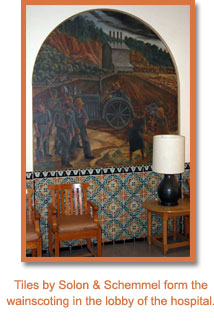
Tile Heritage has written the hospital administrator to establish the importance of the tiles and terra cotta and to express
concern that they be safeguarded. We have been verbally assured by the administrator’s secretary that the lobby will be
maintained as is, but to date the administrator has not responded directly to our inquiries.
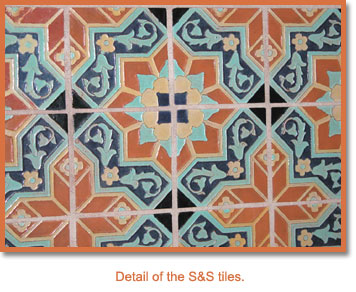
Established in 1866 as “The Almshouse,” a shelter for the homeless, the hospital quickly evolved when it was hastily called
upon to treat smallpox patients during the 1868 epidemic. Later, in 1906, “The Relief Home” was called upon to provide care
and emergency housing for victims of the earthquake and fire. Shortly after, a hospital section for the chronically ill
opened. In 1926, the first units of the main building were completed with the last units coming into service in 1940. In
1963, Laguna Honda was formerly accredited as a hospital; at its peak, it had 1,908 beds.
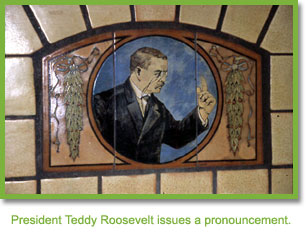
Tile Alert
at
Roosevelt Junior High, Pennsylvania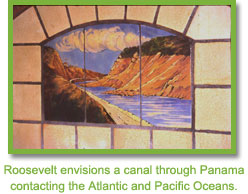 In 1924, W.W. Myers, architect for the Erie School District, designed Roosevelt Junior High School. Quoting Cleota Reed from A Guide to
the Tiles of Erie, Pennsylvania, “This school is a tile treat. Behind its eight water fountains we find tiles depicting hand-painted
scenes from the life of the nation’s 26th President and the school’s namesake, Theodore Roosevelt. The images, by as yet an unidentified
maker, are set in arched three-part panels against pale yellow, mat-glazed backgrounds, and framed by mustard-yellow egg-and-dart relief
patterned moldings.
In 1924, W.W. Myers, architect for the Erie School District, designed Roosevelt Junior High School. Quoting Cleota Reed from A Guide to
the Tiles of Erie, Pennsylvania, “This school is a tile treat. Behind its eight water fountains we find tiles depicting hand-painted
scenes from the life of the nation’s 26th President and the school’s namesake, Theodore Roosevelt. The images, by as yet an unidentified
maker, are set in arched three-part panels against pale yellow, mat-glazed backgrounds, and framed by mustard-yellow egg-and-dart relief
patterned moldings.
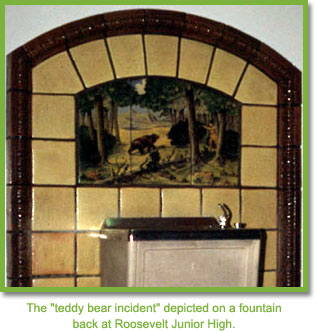
One lettered panel introduces the President. Another presents his portrait within a circle flanked by gatherings of
greens against a bronze luster-glazed background. Three panels illustrate historical sites in his life including the North Dakota ranch
where he lived in the 1880s (now Roosevelt National Park); Sagamore Hill, the house he built in 1884 at Oyster Bay, Long Island; and the
[U.S. Capitol]. Three others show important events in his life: his charge with the ‘Rough Riders’ up Kettle Hill in Cuba in 1898; the
Panama Canal, which he championed; and the ‘teddy bear incident,’ when the famous big game hunter didn’t have the heart to shoot a bear cub.”